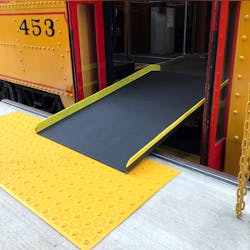MATA implements use of high-tech composites in its service ramps for disabled trolley customers
New service ramps are being deployed on the Memphis Area Transit Authority’s (MATA) rail trolley cars that are made of a lightweight, strong composite material that is traditionally used to reinforce concrete buildings and bridges.
These new composite ramps bridge the gap between the rail trolley and station boarding platform area, and are easily lifted and put into place by trolley operators at specific stops. MATA says the composite ramps are more than 60 percent lighter than the traditional metal ramps and are three times stronger.
The material, referred to as carbon fiber reinforced polymer (FPR) is used for strengthening buildings, bridges and bridge columns, marine ports and other vital structural repairs.
“The use of carbon fiber instead of glass fiber will provide the rail trolley ramps even more strength and durability over other standard materials while remaining a lighter weight solution as compared to traditional metal service ramps,” said Fran Sosa, supervising bridge engineer, WSP USA, the consulting engineers on the project.
The ease of handling the ramps when the rail trolleys stop to board customers promotes both employee and public safety and represents a safer way to load and offload. The ramps are also compliant with the Americans with Disabilities Act (ADA) and allow for safer, more secure loading of wheelchairs, walkers and other assistance devices.
“This is another application of FRP that benefits the public,” said Mo Ehsani, president and CEO of QuakeWrap Inc., and centennial professor emeritus of civil engineering at the University of Arizona. “The weight of these ramps was a primary concern to MATA. Our unique design led to each ramp weighing only 25 pounds, while exceeding the strength and deflection requirements set by the client.”
The first carbon FRP ramp used by MATA is designed specifically for rail Trolley Car 453, a double-truck replica of a Birney, a type of streetcar that was manufactured in the United States in the 1910s and 1920s. The original design was small and light, intended as an economical means of providing frequent service at a lower infrastructure and labor cost than conventional streetcars.
Serving as an on-call engineering consultant to the MATA Trolley Division, WSP USA reached out to QuakeWrap, Inc., for the design and fabrication of the carbon FRP ramps. QuakeWrap is the original company to patent the use of FRP for structural engineering rehabilitation, and the ramps are made at its 8,000-square-foot manufacturing site in Arizona.
MATA says FRP’s ease of installation relative to the cost and energy of replacing an entire structure represents an economical means of repairing or rehabilitating infrastructure with minimal service interruption.
